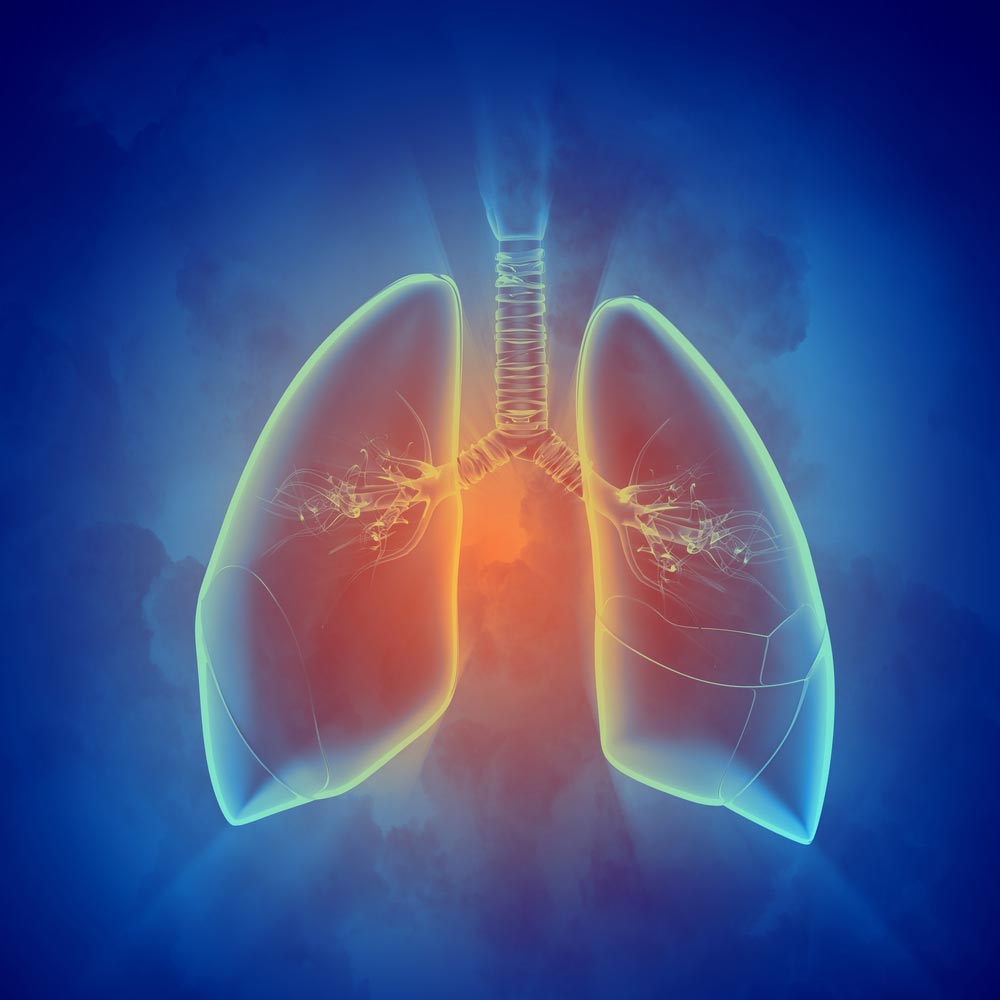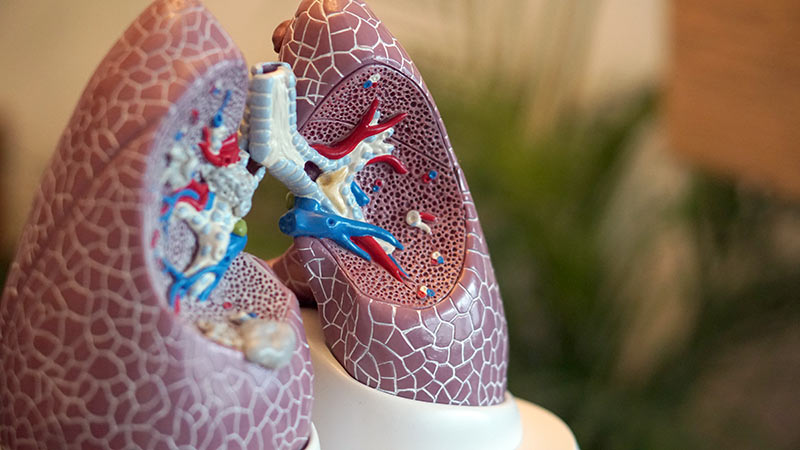Treatment for asthma | chronic obstructive pulmonary disease | pneumonia inflammation of the upper airways | chronic bronchitis | treatment of smoking damage
Cannabidiol (CBD) has become in recent years the preferred choice of many people all over the world for the treatment of a variety of different symptoms and health conditions. CBD, a molecule with many medicinal properties, is unlike the THC intoxicating (psychoactive) molecule and also aroused great interest as a treatment for asthma in lung diseases using CBD oil. Recently, the antibiotic & anti-inflammatory actions of CBD oil has been re-examined. Research showed that CBD is efficient in preventing the development of health sickness factors in the lung and the findings are extremely interesting.
How are the lungs built and what is their function?
The lungs and several other structures make up the respiratory system. The main function of the lungs is to inhale fresh air and deliver its oxygen to the red blood cells that carry it with the bloodstream to all the cells of the body. In addition, carbon dioxide, the by-product of the cellular respiratory process, is also ejected from the lungs through the emitted air. A healthy person has two lungs, a right lung and a left lung, each of which is an independent unit in terms of blood supply. Each lung enters a tube called: branching tubes Bronchioles into nearly 30 million tiny air sacs, the alveoli. The bronchial that enters the lungs and leads to air splits into smaller bronchioles. The walls of the final symphonies are so thin that the exchange of gasses between the blood and the air is already possible within them. The retinoid nats are small air blisters/sacks surrounded by capillaries. When the nat is filled with inhaled air, oxygen (O2) diffusion into the blood in the capillary, which is pumped by the heart into all the tissues of the body. At the same time, diffusion of carbon dioxide (CO2) from the capillaries to the air in the alveoli, and from them, through the symphonies, bronchioles, and trachea, is emitted out through the exhalation action.
Gas Exchange Between Alveolar Spaces and Capillaries
The function of the respiratory system is to move two glasses: oxygen and carbon dioxide. Gas exchange takes place in the millions of alveoli in the lungs and the capillaries that envelop them. As shown below, inhaled oxygen moves from the alveoli to the blood in the capillaries, and carbon dioxide moves from the blood in the capillaries to the air in the alveoli
The Pulmonary Shell (Maple Membrane)
Each of the lungs is wrapped in a double membrane, which plays an important role in the respiratory mechanism. It is a serum membrane – thin and double, whose inner leaf is glued to the lung, and outer to the walls of the thorax, between the two layers of the crust there is a microscopic gap called the maple cavity filled with liquid.
The lungs are placed in a bony basket made of ribs, which are attached from behind to the vertebrae and face the sternum. Between the thorax and the abdominal cavity – beneath it, the diaphragm, made of muscles in its peripheral parts and connective tissue in the centre.
Treating asthma using CBD
Asthma is characterized by chronic lung inflammation and airway hyperresponsiveness. Asthma remains a major public health problem and, at present, there are no effective interventions capable of reversing airway remodelling. A recent study was designed to evaluate the effects of cannabidiol in this scenario. Allergic asthma was induced in Balb/c mice exposed to ovalbumin, and respiratory mechanics, the collagen fibre content in the airway and alveolar septa, cytokine levels, and CB1 and CB2 expression were determined. Moreover, expressions of CB1 and CB2 in induced sputum of asthmatic individuals and their correlation with airway inflammation and lung function were also evaluated. CBD treatment, regardless of dosage, decreased airway hyperresponsiveness. These outcomes were accompanied by decreases in collagen fibre content in both airway and alveolar septa and the expression of markers associated with inflammation in the bronchoalveolar lavage fluid and lung homogenate. There was a significant and inverse correlation between CB1 levels and lung function in asthmatic patients. CBD treatment decreased the inflammatory and remodelling processes in the model of allergic asthma.

Inducing experimental asthma in rats by introducing the substance – Ovalbumin (the main avian blood protein) triggered inflammation in the bronchi, with cytokine levels in the blood rising accordingly. CBD treatment lowered the release of cytokines and their blood level decreased. CBD has been found to have medical potential to calm the inflammatory response to asthma. Besides suppressing inflammation, CBD inhibits mucus production thus reducing airway obstruction and preventing the worsening of asthma in humans. Cytokine IL-13 is the cytokine that causes increased mucus production in the airways. A recent study found that CBD lowers levels of this cytokine in the airways, protects the lung tissue from infections, and thus treats and assists in respiratory diseases and asthma.
T cells penetrate the respiratory system and produce cytokines in response to asthmatic stimulation. CBD suppresses the T-cell reaction and inhibits the release of cytokines. A 1999 study (Waksman, Y. et al) found that the cytokine tumour necrosis factor – TNF plays an important role in creating inflammation and increasing the severity of asthma. CBD lowers the cytokine TNF level and thus helps calm inflammation.
It turns out in recent studies that the induction of asthma in animals has caused an increase in anandamide levels in the fluid of the airways. the higher level of anandamide decreased asthma severity.
CBD raises anandamide levels as a result of the inhibition of the FAAH enzyme that breaks down anandamide, thus helping anandamide in the respiratory vessels and soothe asthma. By these results, treating asthma using CBD oil is a promising and potentially great option for the near future.
Read in-depth about CBD as a Natural Treatment for Asthma:
Cannabidiol reduces airway inflammation and fibrosis in experimental allergic asthma
Activation of cannabinoid receptors prevents antigen-induced asthma-like reaction in guinea pigs
Endogenous cannabinoid receptor agonists inhibit neurogenic inflammations in guinea pig airways
Evaluation of Serum Cytokines Levels and the Role of Cannabidiol Treatment in Animal Model of Asthma
Chronic Obstructive Pulmonary Disease
A disease that creates a restriction on the airflow that is not completely reversible. The disease is characterized by an advanced course and at the same time exacerbation.
The characteristic clinic includes shortness of breath in tan effort and chronic cough. Smoking is the most significant risk factor. The main treatment for exacerbating the disease includes oxygen supply, bronchiole expanders, and systemic steroids (liquid or powdery spray). Patients who suffer moderate or severe worsening add antibiotic treatment. Quitting smoking reduces the mortality rate and the risk of further worsening significantly.
Risk factors: Smoking – stopping smoking should be encouraged at all times. indoors (cooking oil, heating in an unventilated room) and outside the home, and occupational air pollution (dust and chemicals).
Prenatal factors: Any factor that affects the maturation of the lungs until birth and during childhood (low birth weight, pulmonary infections, etc..) increases the risk of having the disease later in life.
CBD as a treatment for Chronic Obstructive Pulmonary Disease [COPD]
During decades of research in the field of medical cannabis, researchers pointed to the effectiveness of cannabis in treating diseases and symptoms associated with lung diseases and respiratory tracts. All the results from individual studies conducted, and anecdotal reports showed that lowering inflammation helps chronic bronchitis patients, even though the way of consumption was in smoking. Activation of the CB1 and CB2 receptors by THC showed a reduction in respiratory inflammation.
Animal research summarized the findings and determined that CBD has great potential as an anti-inflammatory drug and improves lung function. Another study found that CBD has a positive effect after acute lung injury, especially in preventing subsequent infections.
CBD as a natural treatment for Bronchitis
CBD can reduce bronchitis and other chronic obstructive pulmonary diseases by expanding the airways, lowering resistance in the alveoli, and increasing the air current to the bronchial tubes. Another study found that activating CB1 receptors in the lungs prevents contractions of the smooth muscle that surrounds the air vessels of the lungs and also helps to expand the air ducts.
CBD as a natural treatment for respiratory diseases
Infections are the most common form of expression of many respiratory and lung diseases. CBD treatment during an ongoing inflammatory process in the body has great anti-inflammatory potential. All previous studies in animals and lung tissues in the laboratory showed a clear withdrawal of inflammation due to CBD treatment and thus opened the way for further current research in humans.
Recently, CBD’s antibiotic action has been re-examined and it has become clear that it has strong antibiotic activity and thus prevents the development of disease factors. In the past, the only way to consume cannabinoids was by smoking. The vast majority of doctors vigorously opposed this method of consumption. Today, hemp extractions and a variety of products taken by swallowing and absorbed under the tongue make CBD a natural and safe treatment for respiratory tract infections.
Antibacterial activity of delta9-tetrahydrocannabinol and cannabidiol
Antibacterial cannabinoids from Cannabis sativa: A structure-activity study
What is now known in the Study:
Shortly, In asthma patients, the airways are extremely sensitive to various stimuli, causing allergies that stimulate and worsen bronchial health. These stimuli can be smoke, cold air, or physical exercise. As a result of exposure to these irritating substances, immune cells, found in the walls of the airways, release substances that encourage inflammation and substances that cause smooth muscle contraction in the wall of the air ducts. A sudden and strong contraction of the muscle in the wall of the air ducts is what leads to acute shortness of breath.
Symptoms include:
Wheezing in the breath
Bouts of coughing and shortness of breath
Chest pain
Nocturnal cough
About 10% of the world’s population suffers from bronchial diseases. Asthma is a disease that causes considerable suffering and a significant reduction in the quality of life, if not diagnosed and treated properly. The diagnosis and evaluation of the severity of the bronchial disease consist of a clinical and laboratory diagnosis that relies on on and uses lung function and diagnosis of the allergic condition. The current treatment includes reducing exposure to aggravating factors, medication, and immuno-modulators treatment.
Other Lung Diseases that CBD treatment can be useful for:
Pneumonia is a lung infection that can cause very severe disease. The inflammation manifests itself in coughing, fever, and difficulty breathing. In many cases, it seems that pneumonia is generated as a result of the complication of another respiratory disease, such as the flu. Pneumonia can be treated at home with some antibiotics. It usually passes two or three weeks later. However, among older people and infants, the disease can be very serious and even fatal. In more severe cases, patients tend to be hospitalized until the infection passes and provided oxygen to facilitate breathing. For those patients in the risk group for severe pneumonia, a vaccine against the main bacterial infection factor, Pneumococci is offered.
Pneumococci are a type of streptococcus bacteria. The bacteria spread through contact with people who are ill or by healthy people who carry the bacteria in the back of their nose. Pneumococcal infections can be mild or severe.
Upper Respiratory Tract Infection
A disease is commonly called “colds”. The airways include the following organs: nose, pharynx, throat, trachea, and healthy bronchial. Inflammation of the upper airways is very common, and it is one of the most common reasons to visit a doctor of all ages. In most cases it is an infection caused by viruses and manifested in the following symptoms: Nasal congestion, excessive secretion of the mucous membranes of the airways (e.g. runny nose and phlegm), sneeze, cough, and sore throat. However, upper respiratory tract infection can be an allergic reaction and not necessarily due to infection.
Respiratory congestion may be accompanied by inflammation in the conjunctivitis of the eyes, sore throat, hushes, and cough. Clogged ears, facial pain, feeling of congestion in the area of the forehead or cheeks, and sometimes headaches. In the case of influenza, which is a unique disease of the upper airways, usually not only do the usual symptoms – such as runny nose, sore throat, and cough – appear, but also high fever, general bad feeling, and muscle pain throughout the body.
Chronic Bronchitis
Bronchioles are the tubes that transport air to the lungs. These tubes are covered on the inside with a thin layer of cells known as mucous membranes. When there is an inflammation it causes edema and secretion of a lot of phlegm. Viruses are the main generator of acute bronchitis. On the other hand, the cause of chronic bronchitis is contaminants that are in the air and that are inhaled into the lungs. The main cause of chronic brothel inflammation is cigarette smoke, but also severe air pollution or continuous exposure to dust can cause this inflammation. An allergic reaction is another possible cause of chronic bronchitis. Symptoms of bronchitis (acute or chronic) are coughing, phlegm emissions, weakness, fever, and sometimes chest discomfort – especially after coughing. Inflammation is defined as chronic when symptoms persist for at least three months each year for two years in a row.
Read more about CBD and treatment for inflammatory lung diseases:
CBD and treatment for damage done by smoking:
CB2 receptors of the endocannabinoid system [ECS] are responsible for monitoring and regulating inflammatory processes in the body as well as the regeneration of fibrotic tissues.
Nicotine causes the formation of dead connective tissue (scar) in the lung tissue, whose condition is improved by treating JWH 133 the specific agonist of CB2 receptors. This improvement is reduced by treatment with the unique antagonist of CB2 receptors – AM-630. According to these results, using the JHW-133 can help wean the way from nicotine addiction.
The importance of the study is the relationship between the endocannabinoid system and the inflammatory process that creates dead connective tissue and the proof that cannabinoids will have a positive effect on the prevention of the process.
JWH-133 is a potent selective CB2 receptor agonist with a Ki of 3.4 nM and selectivity of around 200x for CB2 over CB1 receptors. It was discovered by and named after, John W. Huffman. It’s important to note that 3-(1′,1′-Dimethylbutyl)-1-deoxy-delta-8-THC is a selective CB2 agonist, binding 677nM at Cb1 and 132 3.4nM at CB2 while 3-(1′,1′-Dimethylbutyl)-delta-8-THC itself binds 65nM at CB1. Structurally the only difference between JWH-133 and dimethylbutyl-D8-THC is that JWH-133 lacks the hydroxyl group seen on the dimethylbutyl-D8-THCs phenol structure (the C1 position of the A ring), turning this group into a phenyl (JWH-133) instead of phenol. It’s generally accepted that removing the hydroxyl group from the phenol structure of any classical cannabinoid benzopyran (such as THC) results in dramatically less CB1 activity and heightened CB2 activity. JWH-133, alongside WIN 55,212-2 and HU-210, is responsible for preventing the inflammation caused by Amyloid-beta proteins involved in Alzheimer’s disease, in addition to preventing cognitive impairment and loss of neuronal markers. This anti-inflammatory action is induced through agonist action at the CB2 receptor, which prevents microglial [MG] activation that elicits inflammation. Additionally, cannabinoids at this receptor completely abolish neurotoxicity related to MG activation in rat models
CB2R agonist prevents nicotine-induced lung fibrosis
AM-630 (6-Iodopravadoline) is a drug that acts as a potent and selective inverse agonist for the cannabinoid receptor CB2, with a Ki of 32.1 nM at CB2 and 165x selectivity over CB1, at which it acted as a weak partial agonist. It is used in the study of CB2 mediated responses and has been used to investigate the possible role of CB2 receptors in the brain. AM-630 is significant as one of the first indole derived cannabinoid ligands substituted on the 6-position of the indole ring, a position that has subsequently been found to be important in determining affinity and efficacy at both the CB1 and CB2 receptors, and has led to the development of many related derivatives.
Cystic fibrosis [CF]:
Cystic fibrosis is a multi-system hereditary disease, manifested in viscous and thick secretions due to damage to the mechanism of the passage of salts in the cells. The result is the blockage of tubes in the various body systems: The respiratory system, the digestive system (pancreas and bile), and the sweat glands.
Obstruction of the airway causes recurrent infections and the destruction of cells in the lungs. Gastrointestinal blockages cause a decrease in the absorption of essential food components to the body and impair insulin secretion. In addition, it turned out that CF patients produce less SURFACTANT that coats endothelial cells and are therefore easily affected by viral and bacterial infections.
surfactant, also called surface-active agent, a substance such as a detergent that, when added to a liquid, reduces its surface tension, thereby increasing its spreading and wetting properties. The surface-active molecule must be partly hydrophilic (water-soluble) and partly lipophilic (soluble in lipids, or oils).
Benefits of CBD for the treatment of CF:
CBD does not cause addiction and there is no need for dose increase (the body barely develops a tolerance for CBD).
CBD has no significant side effects.
CBD does not cause a “high” euphoric feeling or intoxication and does not disrupt the routine of the day.
It is important to note that CBD is not a cure and it affects each person individually!
Some people react very quickly to CBD mainly in pain relief & sedation, while others feel the effect after a long time. Most people quickly find the dosage and the ideal form of consumption that has the maximum effect on their condition, maintaining stability and continuity in treatment.
Want to experiment with quality CBD products?
MOYA recommends several products suitable for treating a variety of problems, it is worth taking a look at the store and learning our many products. For free advice and to select the right product for you – contact us



